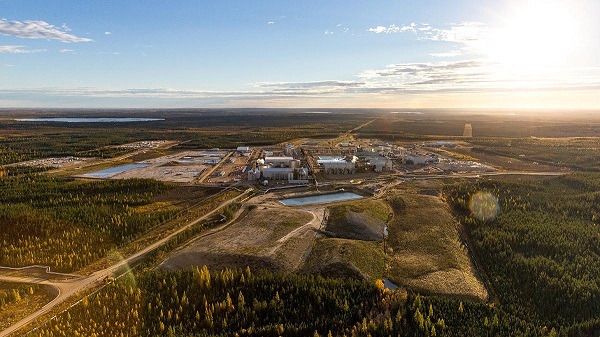Alberta
‘Significant change’ in oil sands emissions growth while sector nears $1 trillion in spending

In situ oil sands project in northern Alberta. Photo courtesy MEG Energy
From the Canadian Energy Centre
‘The oil sands are Canada’s winning lottery ticket’
As Alberta’s oil sands sector reaches a major economic milestone, a new report shows that emissions growth continues to slow.
There is a clear “structural break” for the industry where production growth is beginning to rise faster than emissions growth, according to S&P Global Commodity Insights. While last year’s oil sands production was nine per cent higher than in 2019, total emissions rose by just three per cent.
“It’s not driven solely by slower production growth because production growth has continued. This is a notable, significant change in oil sands emissions,” said Kevin Birn, head of S&P Global’s Centre for Emissions Excellence.
Birn said that in many cases oil sands growth is coming from optimization, where for example instead of companies building new equipment to generate more steam to inject underground, they have found ways to produce more oil with the steam they already have.
Emissions per barrel, or so-called “emissions intensity” is now 28 per cent lower than it was in 2009.
Earlier this year, S&P Global raised its oil sands production outlook, now projecting the sector will reach 3.8 million barrels per day by 2030, compared to 3.2 million barrels per day in 2023.
Analysts continue to expect total oil sands emissions to peak in the next couple of years, absent the federal government’s proposed oil and gas emissions cap.
“Certainly, there’s potential for that to occur later if there’s more volume than we anticipate, but it’s also the time when we start to see the potential for large-scale decarbonizations to emerge towards the end of this decade,” Birn said.
Meanwhile, before the end of this year the oil sands sector will hit approximately $1 trillion of cumulative spending over the last 25 years, according to a joint report by the Macdonald-Laurier Institute and Pathways Alliance.
That is, not profits or dividends, but investment in operations, building new facilities, and government payments including taxes and royalties.
“The oilsands are Canada’s winning lottery ticket,” wrote MLI’s Heather Exner-Pirot and Pathways’ Bryan Remillard.
They noted that oil sands producers have paid more than $186 billion in royalties and taxes to Canadian governments, representing more than the last five years of Canadian defense spending.
“Far from just an Alberta success story, the oilsands are a quintessentially Canadian sector. More than 2,300 companies outside of Alberta have had direct business with the oilsands, including over 1,300 in Ontario and almost 600 in Quebec,” wrote Exner-Pirot and Remillard.
“That juggernaut could keep Canada’s economy prosperous for many more decades, providing the feedstock for chemicals and carbon-based materials whenever global fuel consumption starts to decline.”
That is, unless companies are forced to cut production, which credible analysis has found will happen with Ottawa’s emissions cap – well over one million barrels per day by 2030, which Exner-Pirot and Remillard said would have to come almost entirely from Canada’s exports to the United States.
“If companies are forced to cut their production, they won’t be able to afford to aggressively cut emissions. Nor will they be able to make other investments to maximize and sustain the value of this resource.”
Alberta
Made in Alberta! Province makes it easier to support local products with Buy Local program

Show your Alberta side. Buy Local. |
When the going gets tough, Albertans stick together. That’s why Alberta’s government is launching a new campaign to benefit hard-working Albertans.
Global uncertainty is threatening the livelihoods of hard-working Alberta farmers, ranchers, processors and their families. The ‘Buy Local’ campaign, recently launched by Alberta’s government, encourages consumers to eat, drink and buy local to show our unified support for the province’s agriculture and food industry.
The government’s ‘Buy Local’ campaign encourages consumers to buy products from Alberta’s hard-working farmers, ranchers and food processors that produce safe, nutritious food for Albertans, Canadians and the world.
“It’s time to let these hard-working Albertans know we have their back. Now, more than ever, we need to shop local and buy made-in-Alberta products. The next time you are grocery shopping or go out for dinner or a drink with your friends or family, support local to demonstrate your Alberta pride. We are pleased tariffs don’t impact the ag industry right now and will keep advocating for our ag industry.”
Alberta’s government supports consumer choice. We are providing tools to help folks easily identify Alberta- and Canadian-made foods and products. Choosing local products keeps Albertans’ hard-earned dollars in our province. Whether it is farm-fresh vegetables, potatoes, honey, craft beer, frozen food or our world-renowned beef, Alberta has an abundance of fresh foods produced right on our doorstep.
Quick facts
- This summer, Albertans can support local at more than 150 farmers’ markets across the province and meet the folks who make, bake and grow our food.
- In March 2023, the Alberta government launched the ‘Made in Alberta’ voluntary food and beverage labelling program to support local agriculture and food sectors.
- Through direct connections with processors, the program has created the momentum to continue expanding consumer awareness about the ‘Made in Alberta’ label to help shoppers quickly identify foods and beverages produced in our province.
- Made in Alberta product catalogue website
Related information
Alberta
Province to expand services provided by Alberta Sheriffs: New policing option for municipalities

Expanding municipal police service options |
Proposed amendments would help ensure Alberta’s evolving public safety needs are met while also giving municipalities more options for local policing.
As first announced with the introduction of the Public Safety Statutes Amendment Act, 2024, Alberta’s government is considering creating a new independent agency police service to assume the police-like duties currently performed by Alberta Sheriffs. If passed, Bill 49 would lay additional groundwork for the new police service.
Proposed amendments to the Police Act recognize the unique challenges faced by different communities and seek to empower local governments to adopt strategies that effectively respond to their specific safety concerns, enhancing overall public safety across the province.
If passed, Bill 49 would specify that the new agency would be a Crown corporation with an independent board of directors to oversee its day-to-day operations. The new agency would be operationally independent from the government, consistent with all police services in Alberta. Unlike the Alberta Sheriffs, officers in the new police service would be directly employed by the police service rather than by the government.
“With this bill, we are taking the necessary steps to address the unique public safety concerns in communities across Alberta. As we work towards creating an independent agency police service, we are providing an essential component of Alberta’s police framework for years to come. Our aim is for the new agency is to ensure that Albertans are safe in their communities and receive the best possible service when they need it most.”
Additional amendments would allow municipalities to select the new agency as their local police service once it becomes fully operational and the necessary standards, capacity and frameworks are in place. Alberta’s government is committed to ensuring the new agency works collaboratively with all police services to meet the province’s evolving public safety needs and improve law enforcement response times, particularly in rural communities. While the RCMP would remain the official provincial police service, municipalities would have a new option for their local policing needs.
Once established, the agency would strengthen Alberta’s existing policing model and complement the province’s current police services, which include the RCMP, Indigenous police services and municipal police. It would help fill gaps and ensure law enforcement resources are deployed efficiently across the province.
Related information
-

 Alberta10 hours ago
Alberta10 hours agoProvince to expand services provided by Alberta Sheriffs: New policing option for municipalities
-

 Bruce Dowbiggin5 hours ago
Bruce Dowbiggin5 hours agoIs HNIC Ready For The Winnipeg Jets To Be Canada’s Heroes?
-

 2025 Federal Election7 hours ago
2025 Federal Election7 hours agoCSIS Warned Beijing Would Brand Conservatives as Trumpian. Now Carney’s Campaign Is Doing It.
-

 2025 Federal Election9 hours ago
2025 Federal Election9 hours agoNo Matter The Winner – My Canada Is Gone
-

 Alberta8 hours ago
Alberta8 hours agoMade in Alberta! Province makes it easier to support local products with Buy Local program
-

 Health6 hours ago
Health6 hours agoHorrific and Deadly Effects of Antidepressants
-

 2025 Federal Election2 days ago
2025 Federal Election2 days agoThe “Hardhat Vote” Has Embraced Pierre Poilievre
-

 COVID-192 days ago
COVID-192 days agoThe Pandemic Justice Phase Begins as Criminal Investigations Commence



